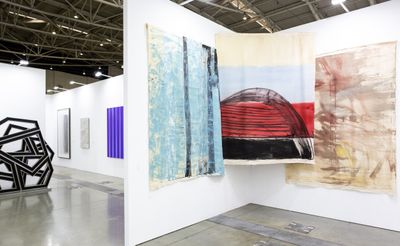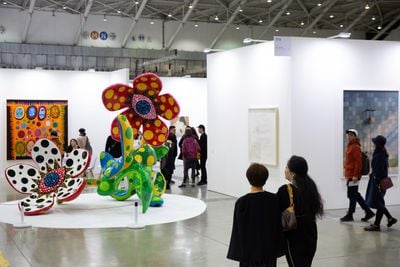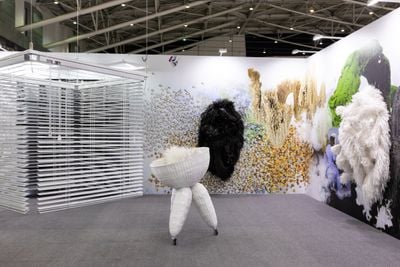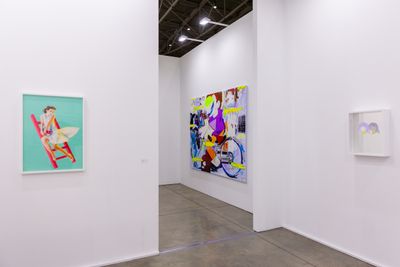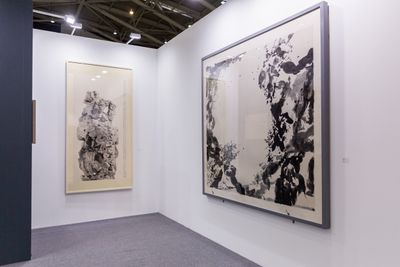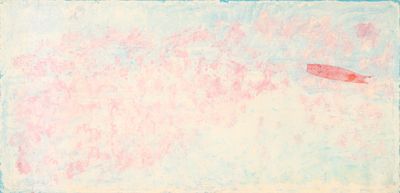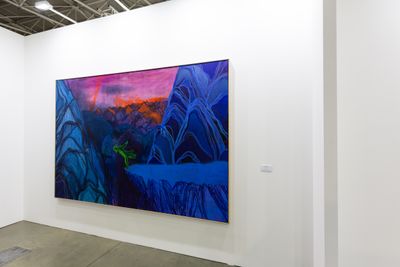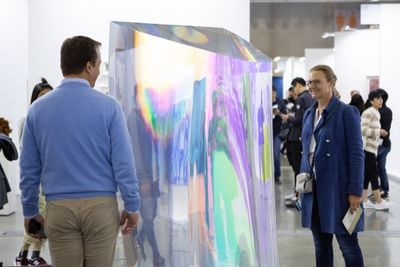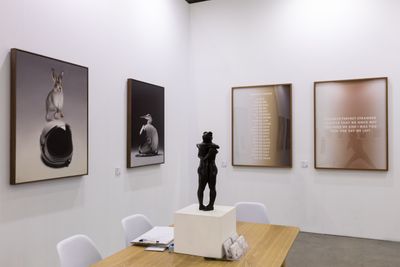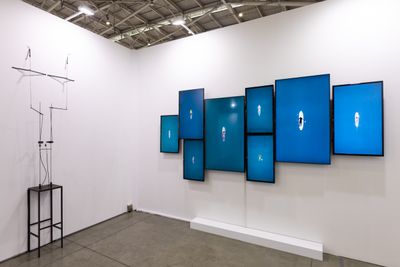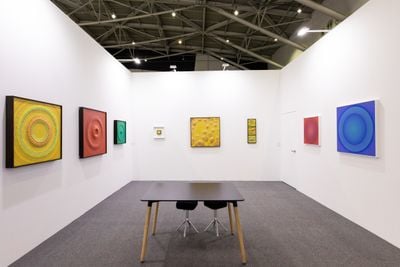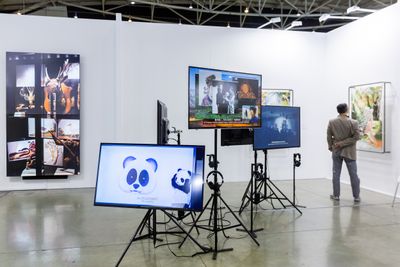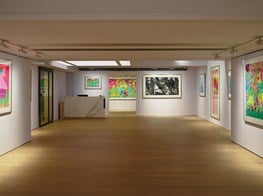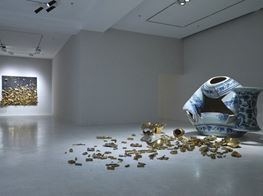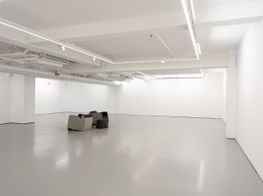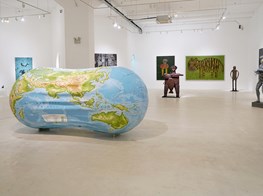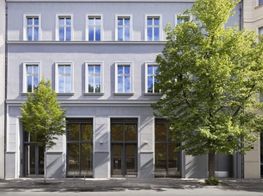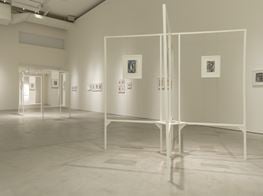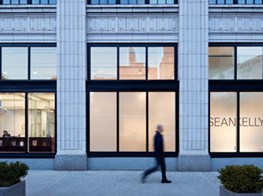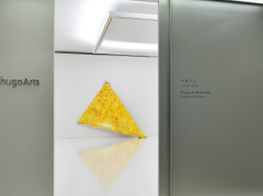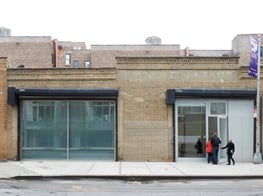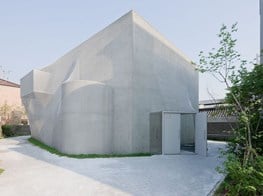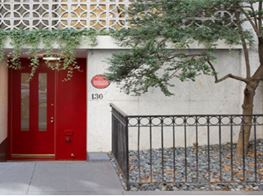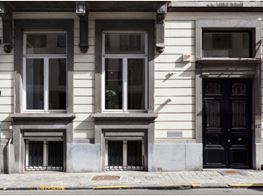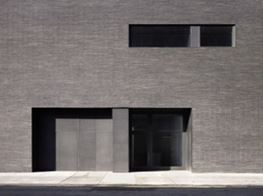Taipei Dangdai: Art Fair as Ecosystem
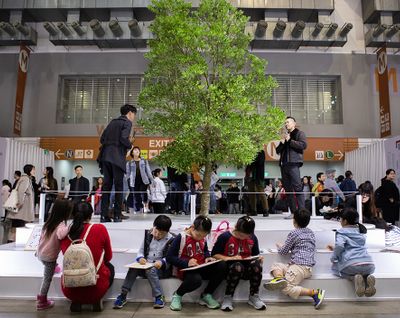
John Yuyi, I Tree to Call You (2018). Exhibition view: Installations sector, Gallery Vacancy, Taipei Dangdai (18–20 January 2019). Courtesy Taipei Dangdai.
For the first edition of Taipei Dangdai (18-20 January 2019), connections with the theme of the 11th Taipei Biennial 'Post Nature—A Museum as an Ecosystem', came through on the fair floor.
There was a great connection between the first edition of Taipei Dangdai (18–20 January 2019), staged on the 4th floor of the Nangang Exhibition Center, and the 11th Taipei Biennial, Post Nature—A Museum as an Ecosystem (17 November 2018–10 March 2019). Installed at the fair's entrance was John Yuyi's live tree, I Tree to Call You (2018), presented by Gallery Vacancy as part of the Installations sector. The tree stood at the centre of a pedestal, surrounded by enthusiastic visitors of all ages, some drawing pictures, others clamouring to take selfies: a microcosm of the palpable excitement among visitors, who spread into every nook and cranny of the fair hall.
Yuyi's tree echoed Henrik Håkansson's Inverted Tree (Reflected) (2018), an Elaeocarpus sylvestris hanging upside down from the ceiling of the Taipei Fine Arts Museum's entrance hall as part of the museum's ongoing Biennial—also the stage for many an excited photo op.
The idea of the museum as an ecosystem resonated with the art fair as a networked ecology in the context of Taipei Dangdai. Ninety participating galleries—including Western heavyweights (such as Pace Gallery, Lehmann Maupin, and Hauser & Wirth) and Asian stalwarts (including Beijing Commune, Hakgojae Gallery, ONE AND J. Gallery, and Taka Ishii Gallery)—were organised into a main Galleries sector with 73 booths, a Solos sector of 13 booths showcasing the work of a single artist, four galleries operational for less than eight years dispersed across the floor as part of the Young Galleries initiative, and a Salon area, where works under USD 8,000 were hung on the walls of a restaurant hosted by GastroJoy.
Some artist names overlapped between the two events, including Taipei Biennial artist (and documenta 14 standout) Vivian Suter, whose paintings were on view at Gladstone Gallery; and Martha Atienza, showing a single-channel edition of Our Islands 11°17'19.6"N 123°43'12.5"E (2016) at Silverlens: a video of an underwater procession of men dressed in costumes that refers to the Ati-Atihan festival in the Philippines, whose 2017 version, Our Islands 11°16'58.4"N 123°45'07.0"E, has done the rounds at recent shows including the Taipei Biennial and the Asia Pacific Triennal.
Throughout the fair, galleries expanded on the theme of nature—and networks—as either a direct subject or metaphor. At Ota Fine Arts, two large flower sculptures by Yayoi Kusama, from the series 'Flowers That Bloom at Midnight' (2010 and 2016) took centre stage at the front of the booth; while inside, Tsuyoshi Hisakado's corner installation of flashing lamps arranged in a kind of disordered matrix, FUZZ (2015), was shown alongside documentize #4 (2018), a pigment and colour pencil on paper work mapping out a constellation of lines and gold orbs, also by Hisakado.
Installed nearby was Cheng Ran's The Lament: Mountain Ghost (2018): a single-channel video showing the front view of the artist painted white and cycling, with lines on his body and face revealing flickers of indiscernible images behind him.
Nature, technology, and bodies converged at Kukje Gallery's solo focus on Haegue Yang. Mixed-media anthropomorphic sculptures were framed by walls covered in Incubation and Exhaustion (2018): a wallpaper created with graphic designer Manuel Raeder of a hybrid landscape composed of photographic collages melding natural and technological forms. Nature and tech met again at Michael Ku Gallery's booth, with Luo Jr-Shin's Coconut Escape (2017): a collection of coconut-flavoured air fresheners perched on individual shelves, shown alongside a motor-driven installation of a scroll featuring palm trees foregrounding a blue-green backdrop, over which white Chinese characters are printed—phrases include 'We have no complaints'.
The merger of nature with tech—or the fetishisation of such mergers in art—reached its apex at de Sarthe, where Wang Xin presented the VR work, Enchanted Art World (2018), alongside imagery by Mak Ying Tung 2, including Relic (gameboy) (2018): a lenticular print showing a Gameboy at the centre of a composition that includes cherubs, doves, roses, and daisies.
Luo Jr-Shin's The Banquet was also on view at Michael Ku Gallery. This 2013 photograph of white blossoms shot against a grey background offered a contemporary counterpoint to Gladstone Gallery's stunning silver gelatin prints by Robert Mapplethorpe, depicting flowers shot in the studio: African Daisy (1982), Orchid (1987), Azalea (1979), and Tulip (1986). More Mapplethorpe photographs were spotted at Galerie Thaddaeus Ropac: an inspired side-by-side pairing of Orchids (1980) and NYC Contemporary (1980)—two outstretched arms, one resting on the other, mirroring Orchid's elegant arc of flowers—that recalled the aesthetics of Taipei Countryside at Each Modern, a stunning 1960s silver gelatin print by Teng Nan-Kuang of a woman peering out from a cluster of ferns.
The sumptuous quality of these black and white images was reflected in the acid-hued photorealism of Tomona Matsukawa's Hope you will stay as you are (2019) at Yuka Tsuruno Gallery: a small painting of leaves perspiring against a hot pink background. Matsukawa's image exudes the same airbrushed sensuality of Harumi Yamaguchi's 1980s acrylic paintings of women at Nanzuka: illustrations—including Cute Girl on a Red Ladder (1983)—influenced by the artist's professional work as a graphic artist, and life as an OG Shibuya girl, in the 1970s and 80s.
Luo's contemporary flower shot at Michael Ku Gallery was hung next to The Office (2018), Jian Yi-Hong's ink on paper illustration of naked men and women performing ritualistic acts among potted plants and office furniture; a composition that recalled the side-scroll narrative of Yang Jiechang's epic, allegorical ink on paper landscape, Tale of the Eleventh Day-Golden Mountain (2012–2017), which stretched across a wall at Beyond Gallery's Solos booth.
Rendered with classical brushwork, Tale of the Eleventh Day-Golden Mountain depicts a melange of animals engaging in cross-species fornication: an amazing mash-up of styles recalling Chinese court paintings, Henry Darger's Vivian Girls illustrations, and Hieronymus Bosch's riotous representations of human folly. (The work references Giovanni Boccaccio's 14th-century collection of tales surrounding a group of Florentine men and women who isolate themselves in a villa during the black death, The Decameron, sometimes known as The Human Comedy.)
Contemporary interpretations of classical themes appeared in various booths and in various guises. At Arario Gallery, The Different World (2017), Sun Xun's ink on silk orihon, or fold-out book, showed a landscape view framed by branches executed in expressive brushwork; it was shown alongside the single-channel nine-minute animation, Tears of Chiwen (2017), whose title refers to Chinese dragons that appear as guardians on roof corners in traditional architecture. Tso Gallery showed works that included Liu Dan's hyperrealist ink on paper illustration of a scholar's rock, Taihu Rock in Zhou Garden (2014), and Zao Wou-Ki's expressive black ink strokes on paper that create a luminous, unmarked void at the centre, Untitled (1985).
Tina Keng Gallery paid homage to a giant of Chinese modernist painting by spotlighting two oil on canvas works on the booth's outer wall by the late Wang Pan-Yuan: a black monochrome (Lead, 1985), and a canvas painted a matte shade of ochre with hints of black pushing through, foregrounded by the silhouette of a dog with an elongated neck, gazing up from one bottom corner to the opposite upper corner, where a black, rounded rectangle hovers like a moon (In the Depth of the Night, 1990).
Wang settled in Taiwan in 1949—the same year master painter and calligrapher Yeh Shih-Chiang landed on the island from China, who was the focus of a solo presentation at Hanart TZ Gallery, where a collection of oil paintings by Yeh also included a series of canvases featuring animals set against textured monochromatic surfaces. Sakura Blossoms (2012) shows a pink fish floating on a sea of pastel pinks, blues, and whites; while Owl (2007) consists of an owl's silhouette against a green background
Also showing at Tina Keng were contemporary landscape paintings by Yao Jui-chung, including the triptych Cliffs & Gully: Golden Gully (2018): an ink on paper landscape built up from swirls of red contouring highlighted with gold leaf. This contoured style was echoed in Billy Childish's oil and charcoal landscape, the great cloud (after Segantini) (2014), at neugerriemschneider, as well as in Daniel Richter's oil on canvas Monday Morning (2012) at Galerie Thaddaeus Ropac: lined electric blue mountains foregrounding a burning orange horizon, with a luminous green figure in the centre poised to dive off a cliff.
More contours appeared at Nou Gallery, where works by Wang Tiande—also showing at Alisan Fine Arts—consisted of ink on layered rice paper landscapes, with lines burned into the paper using lit incense sticks, such as Hou Shan–Ascending high to see snow scenery (2018).
Positioned within Nou Gallery's booth was a context-suitable stainless steel Elliptical Column (2016) by Tony Cragg, reminiscent of a scholar's rock. Cragg's sculpture connected with other pieces that referenced this popular—and contemplative—form, including Urs Fischer's cast aluminium and gold leaf plated rock sculpture, Model for The Lovers #2 (2018), at Gagosian; Hsu Yunghsu's porcelain and stoneware clumps arranged to form rock-like mounds at Double Square Gallery; and Jigger Cruz's cast bronze rock (Untitled, 2018) at Gajah Gallery, complemented by a 2018 ink on paper scroll by Li Jin featuring a motley crew of characters, Fall in Love with Wine.
At Sean Kelly, where tribute was paid to Taiwan's master performance artist Tehching Hsieh via posters and statements from between 1978 and 1999, Mariko Mori's standing dichroic-coated acrylic sculpture, Plasma Stone I (2017–2018), felt like a 21st-century interpretation of the scholar's rock as a contemplative abstract shape, with a surface that echoed the pearlescence of Syagini Ratna Wulan's lacquer on resin and Plexiglas paintings at ROH Projects. Offering a looser connection to scholar's rock genre was Daniel Arsham's hydrostone sculptures inlaid with precious stones at Perrotin. Amethyst Eroded Bear (2017), for instance, consists of a purple bear featuring amethyst crystals in 'eroded' sections.
Indeed, references to—and updates on—recognisable tropes came from both sides of the cultural line; no doubt a reflection of collector tastes in Taiwan, which reportedly favour classical themes, many of which centre on the natural world. (Paintings of everyday scenes, such as Noel McKenna's grouping at mother's tankstation, which was complemented by Chihoi's stunning selection at Gallery EXIT, also proved popular.) Beyond landscapes and scholar's rocks, there were birds everywhere, including Tracey Emin's red neon bird perched on a branch, My Favourite Little Bird (2010), at White Cube, and Luc Tuymans' painting of a yellow canary, Isabel (2105), at David Zwirner.
Among a series of intricate images by artist Nerhol at YKG Gallery, created by thickly layering the same inkjet print and carving into it, was Seagull (2018); while Sullivan+Strumpf showed hyperrealistic oil paintings by Sam Leach, in which exotic fauna and fowl, such as an egret, are conjoined to motorcycle helmets (Mercury Egret, 2018). At Yavuz Gallery, a bird's wings became a metaphor in Alfredo and Isabel Aquilizan's Left Wing Project (Belok Kiri Jalan Terus) Wing G and Wing B (2017–2018): a large pair constructed from hand-forged sickles.
In a Solos presentation by InArt Space, Shyu Ruey-Shiann's 'Traveler's Wings' series (2011) included French National Train tickets mechanised to mimic flying birds. The artist was also represented at Double Square Gallery, where a kinetic sculpture of a wire body—whose legs seem to mimic the movement of a swimmer doing breaststroke (Traces, 2011)—was cleverly placed beside eight single screens by Chen Wan-Jen, all from 2019. Each screen features a bird's eye frame of brilliant blue water, with a single body paddling on a surfboard in each.
Chen's Deep Royal Blue (2017), shown on the gallery's outer booth wall, proved photo-popular: a vertical column of four screens, again showing video of sapphire blue waters with swimmers cutting through the monochrome, upwards and downwards. This particular work recalled the vertical, scroll-like logic of Fiona Tan's endless video Vertical Wide (2018), at Wako Works of Art, which focuses on a traffic lane at night, with red lights streaming up one side, and white lights moving down the other.
Some works drew on the religious traditions of the region, including Kao Jun Honn's single-channel video Taoist Trinity Fairyland (2018) at A+ Contemporary, and Takashi Murakami's Amitabha Buddha Descends, Looking Back Over His Shoulder (2015) at Perrotin: a colourful acrylic depiction of the title's Buddha surrounded by bodhisattvas, rendered on canvas mounted on board with gold and platinum leaf accents. At Galerie du Monde, Kwok Hon Sum's collection of ink on paper works seem to refer to the Mogao Caves at Dunhuang, including Buddha Grottoes (1988) and Deeply Enter the Sutra Treasury (2001); while Wang Dongling's Heart Sutra (2018) at iPreciation, presents the Buddhist scripture written in gold acrylic on red, transparent Plexiglas panels making up a standing screen.
Deities hailing from beyond Asia were represented by Kohei Nawa at Arario Gallery, showing blackened, burned effigies of such figures as Athena Nike, Villus-Nike (Black) (2015); while Mizuma Art Gallery's spectacular Solos showing of paintings by Kaneko Tomiyuki focused on divine beasts, such as a dragon and a tiger, in explosive works on Japanese paper composed from mineral pigments, watercolour, acrylic, pen, and foil.
Such celestial references complemented the abstract paintings that populated the floor, recalling the mandala-like precision of layered minimalist pieces like Shirazeh Houshiary's pencil and blue pigment on black Aquacryl canvas, Feel (2018), at Lisson Gallery, or Gutai artist Minoru Onoda's stunning focus in Solos with Anne Mosseri-Marlio Galerie, in which contours and curves built up with mouldable paste are covered in colourful dots. Not to mention Puerta Roja's stunning presentation of works from Carlos Cruz-Diez's 1959 'Physichromie' series, also showing in the Solos sector, which the artist selected himself. At Pearl Lam Galleries, characteristic pieces built up by coloured blocks of Korean mulberry paper by Chun Kwang Young included Aggregation 11-FE008 (2011), in which orange edges move to a luminous yellow centre.
In general, colour and paint filled Pearl Lam's booth, with pieces like Pascale Marthine Tayou's Chalk A (2015), different coloured chalk mounted on wood to form an abstract colourfield 'painting', and Zhu Jinshi's Pressure No.2 (2015), two canvases laden with thick clumps of oil—as displayed in the canvas Left Book (2016), covered in slabs of white and black oil paint—pressed together to form a sandwich.
Beyond updated classical and fine art tropes, some works performed cutting and honest interventions that engaged with the art fair context. At Sprüth Magers, Jenny Holzer's 2015 labradorite footstool inscribed with a text from Truisms (1977–1979)—'Hiding your motives is despicable'—complemented Chou Shih Hsiung's site-specific installation presented by Each Modern, 100 Faces of Youth (2019): black metal oil drums with smirking faces painted on them, and the text 'Art is the safest form of investment' stencilled on their lids. Lee Kit was also on hand to inject some reality into the fair at ShugoArts, with soiled fabric printed with the words: 'And as I'm sinking, the last thing that I think Is did I pay my rent?'
There were flashes of geopolitics, too. Thomas Demand's chromogenic print at Sprüth Magers, Podium (2000), featured the very recognisable year '1989', next to the lesser-known '1389': the year some scholars believe the Da Ming Hunyi Tu map was drawn, said to be the earliest cartographical depiction of the entire African continent. (In 2002, a copy of the map was presented to the South African Government from the People's Republic of China as a symbol of the latter country's non-colonial motives.) While Hsu Chia-Wei's Black and White–Giant Panda (2018), a five-channel video installation set up in the centre of Liang Gallery's booth, recounted a Cold War history through the lives of panda bears, including Chi-Chi, once branded 'communist goods' and refused entry to America.
Black and White–Giant Panda demonstrates at once how far the world has come since the Cold War years, and how much more there is to be done. A sentiment that Taipei Dangdai similarly displayed, with an impressive launch that seamlessly merged classical and contemporary styles and genres across cultures, which clearly left a hungry public—whose enthusiasm signals room for growth—wanting more. As for the sales, time will tell, with most galleries reportedly satisfied, if not encouraged, by the fair's first outing. —[O]

